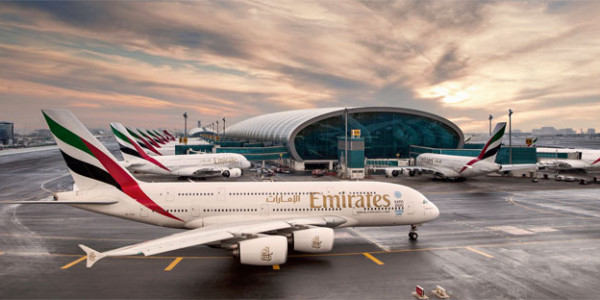Emirates profit soars 52% on record traffic (Abdul Basit) / 10 May 2013 Emirates airline profit jumped by 52 per cent to Dh2.3 billion for the financial year 2012-13 on new routes and capacity expansion. “Our leading national corporations continue to achieve robust results, exemplifying the country’s vision and giving all citizens a source of pride and patriotic spirit,” His Highness Shaikh Mohammed bin Rashid Al Maktoum, Vice-President and Prime Minister of the UAE and Ruler of Dubai, said in his comments on the annual report of Emirates Group. “Such achievements allow us to aspire to higher standards of development and retain a positive outlook in order to sustain our on-going growth,” Shaikh Mohammed said. He said the UAE attaches great importance to the travel and tourism sector. It is an integral part of implementing the country’s strategy for building a sound and sustainable economy, he added. The airline’s revenue reached a record high of Dh73.1 billion growing by 17 per cent compared to 2011-12. Although the average price of jet fuel did not increase over last year, it remains high. In the 2012-13 financial year Emirates’ fuel bill increased by 15 per cent over last year to reach Dh27.9 billion. With total operating costs increasing by 16 per cent compared to a revenue increase of 17 per cent over last year. “Managing volatile exchange rates, coupled with a persistently high fuel bill accounting for 40 per cent of our total expenditures, has required continued strong resolve,” Shaikh Ahmed bin Saeed Al Maktoum, Chairman and Chief Executive of Emirates airline and Group, said in a statement. “Even with these lingering challenges we continue to grow and remain profitable despite the industry norms because we continue to rely on our proven business model and understanding of the marketplace,” said Shaikh Ahmed who is also President of the Dubai Civil Aviation Authority. The airline continued with its growth plan and during the financial year saw the largest increase in capacity in the airline’s history receiving a staggering 34 new aircraft, the highest in any single year and an unprecedented achievement. These aircraft were funded by raising more than $7.8 billion, also a first, through a variety of financing structures. “Emirates has proven once again that despite external challenges, there is good money to be made and it has leveraged that strength through its Dubai hub — a true one-stop connection point for any two cities on Earth,” Saj Ahmad, chief analyst at London-based StrategicAero Research, told Khaleej Times. Overall capacity measured in Available Tonne Kilometres (ATKMs) increased by 5.5 billion tonne-kilometres. Other significant capacity increases include launching 10 new destinations across six continents, shipping more than 2 million tonnes of cargo for the first time and carrying an additional 5.4 million passengers over last year, the highest increase in a financial year. “Staying the course, our strategy for growth has reaped high benefits this past financial year, which has been our strongest ever in relationship to capacity growth,” Shaikh Ahmed said. Emirates seat load factor over the last three years has been 80 per cent despite increase in capacity by 44 per cent during the same period, showing the continued global demand for its product. “We move into the new financial year with confidence and a clear vision of where we are headed. We understand that succeeding in this industry requires determination and we are unapologetic about our drive to be the best,” Shaikh Ahmed said. Carrying a record 39.4 million passengers, an increase of 16 per cent, Emirates logged a robust Passenger Seat Factor, at 80 per cent, remaining consistent with last year’s results. With an increase in seat capacity-Available Seat Kilometres (ASKMs) of 18 per cent the result highlights a strong consumer desire to fly on Emirates’ state-of-the-art aircraft. Passenger yield remained steady with 30.5 fils (8.3 US cents) per Revenue Passenger Kilometre (RPKM). Revenue generated from across Emirates’ six regions continues to be well balanced, with no region contributing more than 30 per cent of overall revenues. With a further 198 aircraft on order worth over $71 billion, combined with the airline’s increasing worldwide passenger traffic, Emirates’ is set to continue to drive considerable economic growth in the countries that it serves. Forging ahead with its intricately planned expansion, Emirates received 34 new wide-body aircraft during the year including 20 Boeing 777-300ERs, 10 Airbus A380s and 4 Boeing 777LRFs compared with last year’s 22 aircraft. With an increased fleet, Emirates launched 10 new destinations in 2012-13 including Ho Chi Minh City, Barcelona, Lisbon, Erbil, Washington, DC, Adelaide, Lyon, Phuket, Warsaw and Algiers. Looking forward to 2013-14, Emirates has to date announced four new routes; Haneda, Clark in the Philippines, Stockholm and Milan to New York. New A380 destinations for the airline in 2012-13 included; Amsterdam, Melbourne, Singapore and Moscow. Bringing the total number of A380 destinations to 21. Focusing on customer touch points, Emirates opened three new dedicated airport lounges during the year including Milan and the new First Class and Business Class Concourse A facilities at Dubai Airport, which are among the largest in the world, bringing the total number of Emirates lounges to 35. abdulbasit@khaleejtimes.com Taylor Scott International
Emirates profit soars 52% on record traffic

This entry was posted in Dubai, Investment, investments, London, News, Taylor Scott International, TSI, Uk and tagged dubai, investments, london. Bookmark the permalink.







